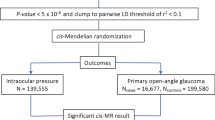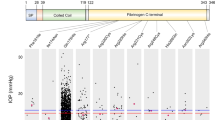Abstract
Glucocorticosteroids commonly used to treat certain ocular inflammatory conditions cause an unwarranted elevation in intraocular pressure (IOP) leading to steroid-induced ocular hypertension (OHT). This study aims to identify novel genetic variants in the Indian population associated with steroid responsiveness, specifically to that of intravitreal Triamcinolone acetonide (TA) injections, which leads to OHT in 27% of the TA-treated Indian subjects. Genetic determinants and pathways regulating TA-OHT progression were investigated by applying whole-genome sequencing (WGS) on DNA extracted from 53 blood samples that included TA responders and non-responders. Sequencing analysis yielded 45 intronic and 49 exonic variants to be associated with TA-OHT, which are known to play a vital role in eye, heart, brain, and bone deformities. Of these, the most significant genetic variant associated with TA-OHT was further considered for molecular dynamics (MD) simulation studies. Variants in the CRPPA, PLOD1, ARHGAP1, TIMELESS and TNFSF4 genes were found to be directly implicating TA-OHT. Furthermore, these genes were enriched in pathways associated with cardiomyopathy, focal adhesion, extracellular matrix, and actin cytoskeleton reorganization. MD simulation studies revealed that the top significant variant (rs141625803) in the CRPPA gene possesses a high pathogenic and structurally destabilizing effect. Thus, novel genetic variants that could be significantly associated with the TA-OHT progression were identified in this study. Validation of these targets in a larger cohort of patients along with their functional analysis would inform on the disease, thereby adding to the existing knowledge on the pathophysiology of TA-OHT.






Similar content being viewed by others
Data availability statement
The data that support the findings of this study are available from the corresponding author upon reasonable request.
References
Athanas-Crannell AJ, Christopher M, Choi Y, Chan A, Zangwill LM, et al., (2018) Gene-Based Analysis Leveraging Whole Genome Sequencing (WGS) Data on Individuals with Multiple Longitudinal Glaucoma Related Phenotypes Shows Evidence for Genetic Factors in Open Angle Glaucoma Progression | IOVS | ARVO Journals. ARVO Meeting, 59 (1182). https://iovs.arvojournals.org/article.aspx?articleid=2689621
Badrinarayanan L, Chitipothu S, Ramasubramanyan S, Sripriya S, Rishi P, Rishi E, George R, Lakshmi BS, Elchuri SV (2020) Assessment of single nucleotide polymorphisms associated with steroid-induced ocular hypertension. Int J Ophthalmol 13(8):1294. https://doi.org/10.18240/IJO.2020.08.17
Badrinarayanan L, Rishi P, George R, Isaac N, Rishi E, SN Vitreo-Retinal group (SNVR) (2022) Incidence, risk factors, treatment and outcome of ocular hypertension following intravitreal steroid injections: a comparative study. Ophthalmologica. https://doi.org/10.1159/000522504
Bendl J, Stourac J, Salanda O, Pavelka A, Wieben ED, Zendulka J, Brezovsky J, Damborsky J (2014) PredictSNP: robust and accurate consensus classifier for prediction of disease-related mutations. PLoS Comput Biol 10(1):e1003440
Bermudez JY, Montecchi-Palmer M, Mao WA (2017) Cross-linked actin networks (CLANs) in glaucoma. Exp Eye Res 159:16–22. https://doi.org/10.1016/j.exer.2017.02.010
Blanco-Marchite C, Sánchez-Sánchez F, López MPG, Iñigez L-M, López-Sánchez E, Alvarez L, Rodríguez PPC, Méndez-Hernández C, Fernández-Vega L, García-Sánchez J, Coca-Prados M, García-Feijoo J, Escribano J (2011) WDR36 and P53 gene variants and susceptibility to primary open-angle glaucoma: analysis of gene-gene interactions. Invest Ophthalmol vis Sci 52(11):8467–8478. https://doi.org/10.1167/iovs.11-7489
Capriotti E, Fariselli P, Casadio R (2005) I-mutant2.0: predicting stability changes upon mutation from the protein sequence or structure. Nucleic Acids Res 33:306–310. https://doi.org/10.1093/nar/gki375
Chaitanya A, Pai VH, Mohapatra AK, Ve RS (2016) Glaucoma and its association with obstructive sleep apnea: a narrative review. Oman J Ophthalmol 9(3):125–134. https://doi.org/10.4103/0974-620X.192261
Chen YY, Hu HY, Chu D, Chen HH, Chang CK, Chou P (2016) Patients with primary open-angle glaucoma may develop ischemic heart disease more often than those without glaucoma: An 11-year population-based cohort study. PLoS ONE 11(9):1–14. https://doi.org/10.1371/journal.pone.0163210
Cheng J, Randall A, Baldi P (2006) Prediction of protein stability changes for single-site mutations using support vector machines. Proteins 62(4):1125–1132. https://doi.org/10.1002/prot.20810
Choi J, Kook MS (2015) Systemic and ocular hemodynamic risk factors in glaucoma. Biomed Res Int. https://doi.org/10.1155/2015/141905
Crilley JG, Boehm EA, Blair E, Rajagopalan B, Blamire AM, Styles P, McKenna WJ, Östman-Smith I, Clarke K, Watkins H (2003) Hypertrophic cardiomyopathy due to sarcomeric gene mutations is characterized by impaired energy metabolism irrespective of the degree of hypertrophy. J Am Coll Cardiol 41(10):1776–1782. https://doi.org/10.1016/S0735-1097(02)03009-7
Elahi E (2020) Genetic basis of primary angle closure glaucoma: the role of collagens and extracellular matrix. J Ophthalmic vis Res 15(1):1–3. https://doi.org/10.18502/jovr.v15i1.5930
Fini ME, Schwartz SG, Gao X, Jeong S, Patel N, Itakura T, Price MO, Price FW Jr, Varma R, Stamer WD (2017) Steroid-induced ocular hypertension/glaucoma: focus on pharmacogenomics and implications for precision medicine. Prog Retin Eye Res 56:58–83. https://doi.org/10.1016/J.PRETEYERES.2016.09.003
Golubnitschaja O, Yeghiazaryan K, Flammer J (2010) Key molecular pathways affected by glaucoma pathology: Is predictive diagnosis possible? EPMA Journal 1(2):237–244. https://doi.org/10.1007/s13167-010-0031-4
Grzybowski A, Och M, Kanclerz P, Leffler C, De Moraes CG (2020) Primary open angle glaucoma and vascular risk factors: a review of population-based studies from 1990 to 2019. J Clin Med 9(3):777. https://doi.org/10.3390/jcm9030761
Ha A, Kim CY, Shim SR, Chang IB, Kim YK (2022) Degree of Myopia and glaucoma risk: a dose-response meta-analysis. Am J Ophthalmol 236(2022):107–119. https://doi.org/10.1016/j.ajo.2021.10.007
Han W, Hu C, Fan ZJ, Shen GL (2021) Transcript levels of keratin 1/5/6/14/15/16/17 as potential prognostic indicators in melanoma patients. Sci Rep 11(1):1–12. https://doi.org/10.1038/s41598-020-80336-8
Huang W, Fan Q, Wang W, Zhou M, Laties AM, Zhang X (2013) Collagen: a potential factor involved in the pathogenesis of glaucoma. Med Sci Moni Basic Res 19:237–240. https://doi.org/10.12659/MSMBR.889061
Jelodari-Mamaghani S, Haji-Seyed-Javadi R, Suri F, Nilforushan N, Yazdani S, Kamyab K, Elahi E (2013) Contribution of the latent transforming growth factor-beta binding protein 2 gene to etiology of primary open angle glaucoma and pseudoexfoliation syndrome. Mol vis 19(February):333–347
Kassa E, Sun Y (2018) Prognostic relevance of elevated intra-ocular pressure in ocular melanoma. Investige Opthalmol Visual Sci. 59(9):3634
Kumar S, Malik MA, Kaur J, Sihota R (2017) Genetic variants associated with primary open angle glaucoma in Indian population. Genomics 109(1):27–35. https://doi.org/10.1016/j.ygeno.2016.11.003
Maeda Y, Ishikawa H, Nishikawa H, Shimizu M, Kinoshita T, Ogihara R, Kitano S, Yamanaka C, Mitamura Y, Sugimoto M, Kondo M, Takamura Y, Ogata N, Ikeda T, Gomi F (2019) Intraocular pressure elevation after subtenon triamcinolone acetonide injection; Multicentre retrospective cohort study in Japan. PLoS ONE 14(12):e0226118. https://doi.org/10.1371/journal.pone.0226118
Melisa Gerzenstein S, & Melisa S (2009) Scholarly Repository Pharmacogenomics of the Intraocular Pressure Response to Glucocorticoids Recommended Citation. http://scholarlyrepository.miami.edu/oa_theses/285
Mirabelli P, Mukwaya A, Lennikov A, Xeroudaki M, Peebo B, Schaupper M, Lagali N (2017) Genome-wide expression differences in anti-Vegf and dexamethasone treatment of inflammatory angiogenesis in the rat cornea. Sci Rep 7(1):1–13. https://doi.org/10.1038/s41598-017-07129-4
Mukhopadhyay A, Komatireddy S, Acharya M, Bhattacharjee A, Mandal AK, Thakur SK, Chandrasekhar BG, Thomas R, Chakrabarti S, Ray K (2005) Evaluation of optineurin as a candidate gene in Indian patients with primary open angle glaucoma. Mol vis 11:792–7978
O’Callaghan J, Cassidy PS (2017) Open-angle glaucoma: therapeutically targeting the extracellular matrix of the conventional outflow pathway. Expert Opin Ther Targets 21(11):1037–1050. https://doi.org/10.1080/14728222.2017.1386174
Othman IS, Assem M, Zaki IMA (2013) Secondary glaucoma as initial manifestation of uveal melanoma. Saudi J Ophthalmol 27:203–208. https://doi.org/10.1016/j.sjopt.2013.07.004
Parthiban V, Gromiha M, Schomburg D (2006) CUPSAT: prediction of protein stability upon point mutations. Nucleic Acids Res 34(2):239–242. https://doi.org/10.1093/nar/gkl19
Pozo M, Fernández-Suárez E, Martín-Sánchez M, Bravo-Gil N, Méndez-Vidal C, La Rúa RE, Borrego S, Antiñolo G (2020) Unmasking retinitis pigmentosa complex cases by a whole genome sequencing algorithm based on open-access tools: hidden recessive inheritance and potential oligogenic variants. J Transl Med 18(1):73. https://doi.org/10.1186/s12967-020-02258-3
Pragati G, Laxmi S, Rubie M, Mona L (2014) A study on systemic risk factors for primary open angle glaucoma. Int J Life Sci Pharma Res 4(2):1–8
Rodrigues CH, Pires DE, Ascher DB (2018) DynaMut: predicting the impact of mutations on protein conformation, flexibility and stability. Nucleic Acids Res 46(1):350–355. https://doi.org/10.1093/nar/gky300
Souma T, Tompson SW, Thomson BR, Siggs OM, Kizhatil K, Yamaguchi S, Feng L, Limviphuvadh V, Whisenhunt KN, Maurer-Stroh S et al (2016) Angiopoietin receptor TEK mutations underlie primary congenital glaucoma with variable expressivity. J Clin Investig 126(7):2575–2587. https://doi.org/10.1172/JCI85830
Stelzer G, Plaschkes I, Oz-Levi D, Alkelai A, Olender T, Zimmerman S, Twik M, Belinky F, Fishilevich S, Nudel R et al (2016) VarElect: the phenotype-based variation prioritizer of the genecards suite. BMC Genomics 17:444–448. https://doi.org/10.1186/s12864-016-2722-2
Swarup G, Sayyad Z (2018) Altered functions and interactions of glaucoma-associated mutants of optineurin. Front Immunol 9:1–12. https://doi.org/10.3389/fimmu.2018.01287
Tang H, Thomas PD (2016) PANTHER-PSEP: predicting disease-causing genetic variants using position-specific evolutionary preservation. Bioinformatics 32(14):2230–2232. https://doi.org/10.1093/bioinformatics/btw222
Vithana EN, Aung T, Khor CC, Cornes BK, Tay WT, Sim X, Lavanya R, Wu R, Zheng Y, Hibberd ML et al (2011) Collagen-related genes influence the glaucoma risk factor, central corneal thickness. Hum Mol Genet 20(4):649–658. https://doi.org/10.1093/hmg/ddq511
Vranka JA, Kelley MJ, Acott TS, Keller KE (2015) Extracellular matrix in the trabecular meshwork: Intraocular pressure regulation and dysregulation in glaucoma. Exp Eye Res 133:112–125. https://doi.org/10.1016/j.exer.2014.07.014
Wang P, Li S, Sun W, Xiao X, Jia X, Liu M, Xu L, Long Y, Zhang Q (2019) An ophthalmic targeted exome sequencing panel as a powerful tool to identify causative mutations in patients suspected of hereditary eye diseases. Transl Vision Sci Technol. https://doi.org/10.1167/tvst.8.2.21
Wiggs JL, Howell GR, Linkroum K, Abdrabou W, Hodges E, Braine CE, Pasquale LR, Hannon GJ, Haines JL, John SW (2013) Variations in COL15A1 and COL18A1 influence age of onset of primary open angle glaucoma. Clin Genet 84(2):167–174. https://doi.org/10.1111/cge.12176
Xie C, Mao X, Huang J, Ding Y, Wu J, Dong S, Kong L, Gao G, Li CY, Wei L (2011) KOBAS 2.0: a web server for annotation and identification of enriched pathways and diseases. Nucleic Acids Res 39:316–322. https://doi.org/10.1093/nar/gkr483
Zhao X, Guan JL (2011) Focal adhesion kinase and its signaling pathways in cell migration and angiogenesis. Adv Drug Deliv Rev 63(8):610–615. https://doi.org/10.1016/j.addr.2010.11.001
Funding
Authors would thank the Indian Council of Medical Research for providing funding (82/19/2012/PHGEN (TF)/BMS) and student fellowship (45/2/2020. HUM/BMS) to perform the whole-genome sequencing study and analysis. The authors would like to thank Medgenome Bangalore for providing the WGS technical analysis.
Author information
Authors and Affiliations
Contributions
LB-performed sample collection, carried out wet-lab experiments, data analysis, and manuscript writing. HN-performed data analysis, and manuscript writing. PR-provided clinical samples explained the drug response of the subjects and their clinical characterization. EPR-provided clinical samples explained the drug response of the subjects and their clinical characterization. RJG-provided clinical samples explained the drug response of the subjects and their clinical characterization. SC-project conceptualization, data analysis, manuscript writing, and editing.
Corresponding author
Ethics declarations
Conflict of interest
Authors declare that they do not have any competing interests.
Additional information
Communicated by Shuhua Xu.
Publisher's Note
Springer Nature remains neutral with regard to jurisdictional claims in published maps and institutional affiliations.
Supplementary Information
Below is the link to the electronic supplementary material.
Rights and permissions
Springer Nature or its licensor holds exclusive rights to this article under a publishing agreement with the author(s) or other rightsholder(s); author self-archiving of the accepted manuscript version of this article is solely governed by the terms of such publishing agreement and applicable law.
About this article
Cite this article
Badrinarayanan, L., Nagarajan, H., Rishi, P. et al. Whole-genome sequencing unravels novel genetic determinants and regulatory pathways associated with triamcinolone acetonide-induced ocular hypertension. Mol Genet Genomics 298, 13–26 (2023). https://doi.org/10.1007/s00438-022-01958-3
Received:
Accepted:
Published:
Issue Date:
DOI: https://doi.org/10.1007/s00438-022-01958-3




